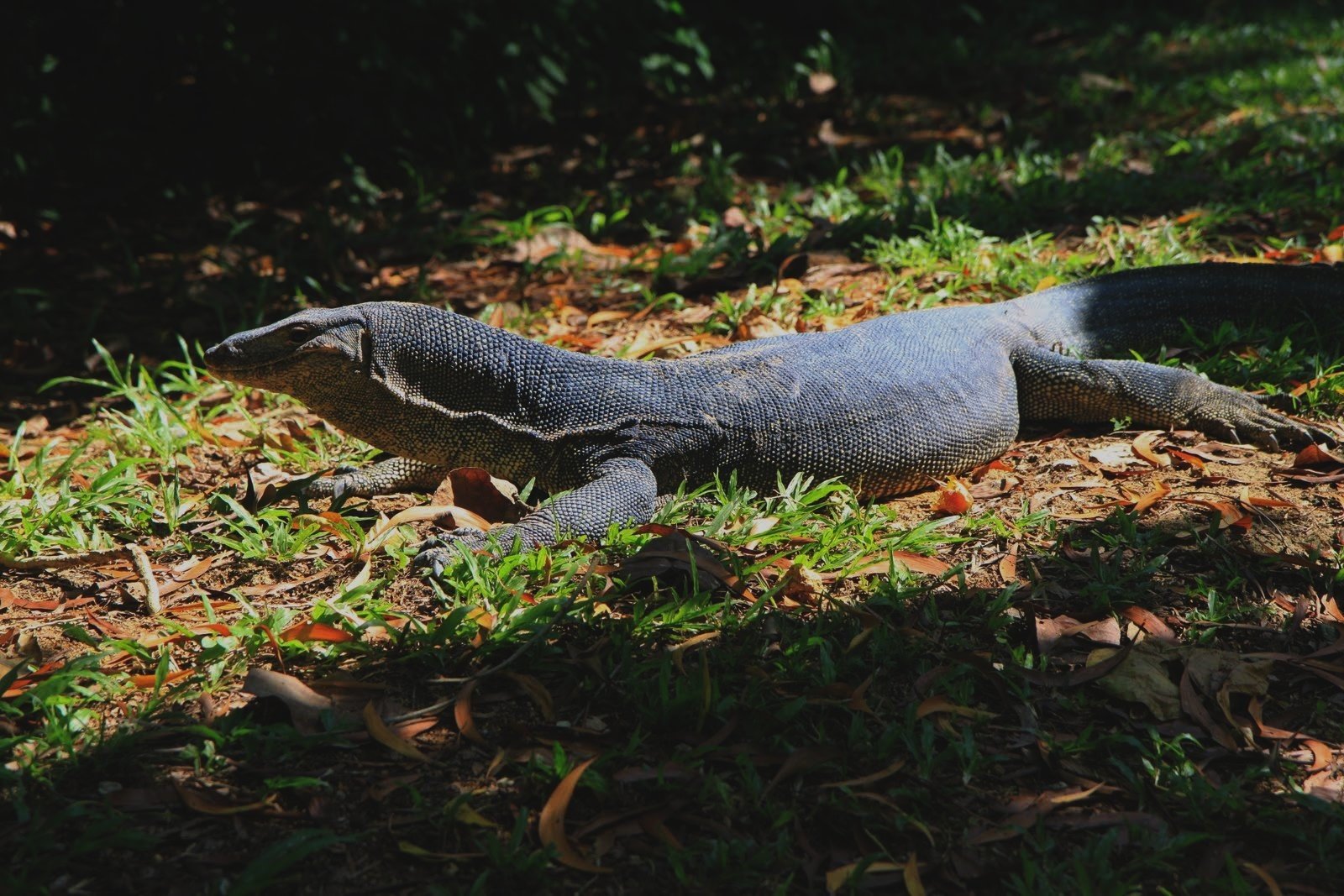I think it is quite obvious that Singapore is not part of Germany, but somewhere “down there” as one of my sisters always says. This description locates a small, teeny, tiny island between the gigantic island Sumatra and the Indian Ocean in the West, the Malaysian Peninsula in the North and the Pacific Ocean in the East and South. If I would say that my favourite girl-friend sleeps in the Northern hemisphere and I sleep in the South in the same bed, then it is not exactly right. Actually, Singapore is located two hours on the high speed boat in the North from the equator.

 With this location of Singapore and its residuals of tropical rain forest, it is pretty obvious that there is an abundance of flora and fauna. Even if you live in the middle of Singapore – unlike us, who are next to a very green park in the East – you will recognise the richness of animals and plants sooner or later. Naturally, for most people it is more interesting to talk about the fauna. The reason is simple: Flowers don’t hide behind scorpions; trees don’t jump from snake to snake; palm trees to not climb on monkeys.
With this location of Singapore and its residuals of tropical rain forest, it is pretty obvious that there is an abundance of flora and fauna. Even if you live in the middle of Singapore – unlike us, who are next to a very green park in the East – you will recognise the richness of animals and plants sooner or later. Naturally, for most people it is more interesting to talk about the fauna. The reason is simple: Flowers don’t hide behind scorpions; trees don’t jump from snake to snake; palm trees to not climb on monkeys.
Yesterday during my evening run in the park, I was reminded of the excellent adaptation of bats into the modern civilisation. Look up to the sky and you see the silent hunters manoeuvring elegantly between palm trees, bushes and houses with high speed. Behind this impressive display of the art of flying works a high performance radar system that needs only a couple of flies a day to function flawlessly.

 On the trees in Singapore you witness more different kinds of birds than in many zoos. Behind our house we often hear and see hornbills, keeping the noise level up. Further away at a canal, different species of herons and cranes feed their youngsters in large nests. Frequently, we recognise eagles hunting for fish at the Pacific Ocean. On our walks or cycling trips to Changi Village or alongside the coast we often hear and see large swarms of parrots in different colours. Some trees in the “jungle” are always worked on by woodpeckers. Nearly on every walk we recognise new birds we have not seen before. Most likely all kinds of birds that live on the Malaysian Peninsula can be seen in Singapore which is only separated from Malaysia by a one to two kilometres wide arm of the Pacific Ocean.
On the trees in Singapore you witness more different kinds of birds than in many zoos. Behind our house we often hear and see hornbills, keeping the noise level up. Further away at a canal, different species of herons and cranes feed their youngsters in large nests. Frequently, we recognise eagles hunting for fish at the Pacific Ocean. On our walks or cycling trips to Changi Village or alongside the coast we often hear and see large swarms of parrots in different colours. Some trees in the “jungle” are always worked on by woodpeckers. Nearly on every walk we recognise new birds we have not seen before. Most likely all kinds of birds that live on the Malaysian Peninsula can be seen in Singapore which is only separated from Malaysia by a one to two kilometres wide arm of the Pacific Ocean.

 The proximity of the Peninsula and its very rich and flourishing fauna have led to some unusual and unwanted visitors to Singapore. Twenty years ago, three grown wild elephants swam through the Pacific to stir up people in some parts of Singapore. Some years ago, there were reports about Malaysian Tigers that have been seen on an island of Singapore. This led to temporary closure of the island and a hunt for tigers. We know this island very well since we go there for cycling quite frequently. We have not spotted a tiger yet. I have to say that we are not too interested in this kind of encounter.
The proximity of the Peninsula and its very rich and flourishing fauna have led to some unusual and unwanted visitors to Singapore. Twenty years ago, three grown wild elephants swam through the Pacific to stir up people in some parts of Singapore. Some years ago, there were reports about Malaysian Tigers that have been seen on an island of Singapore. This led to temporary closure of the island and a hunt for tigers. We know this island very well since we go there for cycling quite frequently. We have not spotted a tiger yet. I have to say that we are not too interested in this kind of encounter.
When I work on the computer sitting on our terrace in the morning – from late morning to evening it is not very clever to sit there due to the powerful equator sun that burns even through the roof of the terrace – I am able to meet a monkey approaching me silently as close as two meters. This happens nearly every day. This macaque has never been inside our house (at least as far as we know), has never dirtied our terrace and has never torn out my hair. Unfortunately, he has done some less nice things in a neighbour’s house which led to the authorities catching our friend and putting him away. Fortunately, on many runs I can spot monkeys in our parks. They are usually friendly, approachable and not too hungry so that they are no danger at all.

 We do have scorpions. Scorpions are usually seen under larger stones or rocks or under piles of wood. We found a scorpion with a whole kindergarten on his back during a walk. Regrettably, I did not have my camera at hand fast enough so that we only got a washed picture of the scorpion family.
We do have scorpions. Scorpions are usually seen under larger stones or rocks or under piles of wood. We found a scorpion with a whole kindergarten on his back during a walk. Regrettably, I did not have my camera at hand fast enough so that we only got a washed picture of the scorpion family.
Other animals are much more forthcoming. In our house you see them hanging at wall and ceiling. Those are just some centimetres long and serve as flycatcher. They really do a great job. We live next to water in the middle of the tropical heat but do not have any flies or other insects in our house. Besides those small guys, we do have the ones that look like little dinosaurs, live in the woods and climb on trees when you disturb them. They are hard to catch on camera. A pity.

 The most common larger animals in Singapore belong to the reptiles. Unfortunately, I have not been able to spot the largest one, the python, with my own eyes in the wild. The python is seen in Singapore frequently and is usually some meters long. Meeting a python is as dangerous as meeting the mother-in-law. You know each other, respect each other but do not step on each other’s toes. When you read reports about pythons having eaten humans you know that this happens in Indonesia and Malaysia. This is impossible in Singapore, since each python is carefully instructed about the laws and regulations on our small island during the immigration process.
The most common larger animals in Singapore belong to the reptiles. Unfortunately, I have not been able to spot the largest one, the python, with my own eyes in the wild. The python is seen in Singapore frequently and is usually some meters long. Meeting a python is as dangerous as meeting the mother-in-law. You know each other, respect each other but do not step on each other’s toes. When you read reports about pythons having eaten humans you know that this happens in Indonesia and Malaysia. This is impossible in Singapore, since each python is carefully instructed about the laws and regulations on our small island during the immigration process.

 Sitting on the terrace working on my computer, I had many encounters with “real” lizards. The first time I hardly took notice of something big and dark greyish moving in through our gate and approaching my table. I saw it only subconsciously working through some stuff. Suddenly, I really recognised the large, about 1.5 meters long animal not far from my leg. As soon as Mr Lizard saw me he cut and ran. They grow much more than a meter and look really impressive, somehow threatening. Singapore monitor lizards are said to be not dangerous at all although their teeth look impressive and they do eat meat. After all, a safe environment is a Singapore promise to all residents and visitors. The dangerous lizards live on Komodo, not far from here. These guys work with a trick: Because of a lack of mouth hygiene they house such aggressive bacteria in their mouth that they only need to “touch” any animal with their teeth. After that this animal starts rotting from that wound upwards and becomes an easy prey for Komodo dragon. These lizards do not exist in Singapore. We do have some supposedly human relatives of the Komodo dragons who share their technique of lack of mouth hygiene. As a result they “kill” their prey with a simple breath.
Sitting on the terrace working on my computer, I had many encounters with “real” lizards. The first time I hardly took notice of something big and dark greyish moving in through our gate and approaching my table. I saw it only subconsciously working through some stuff. Suddenly, I really recognised the large, about 1.5 meters long animal not far from my leg. As soon as Mr Lizard saw me he cut and ran. They grow much more than a meter and look really impressive, somehow threatening. Singapore monitor lizards are said to be not dangerous at all although their teeth look impressive and they do eat meat. After all, a safe environment is a Singapore promise to all residents and visitors. The dangerous lizards live on Komodo, not far from here. These guys work with a trick: Because of a lack of mouth hygiene they house such aggressive bacteria in their mouth that they only need to “touch” any animal with their teeth. After that this animal starts rotting from that wound upwards and becomes an easy prey for Komodo dragon. These lizards do not exist in Singapore. We do have some supposedly human relatives of the Komodo dragons who share their technique of lack of mouth hygiene. As a result they “kill” their prey with a simple breath.

 Additionally, there are all kind of other snakes. Our neighbour told us during our first days in the new house, we should have some 2 meter long poles on our terrace. When I asked him what this is good for he answered “Snakes!”. I thought he wanted to show off when he said that he killed about one snake a year so far. Most of them were cobras. Nice story. Right.
Additionally, there are all kind of other snakes. Our neighbour told us during our first days in the new house, we should have some 2 meter long poles on our terrace. When I asked him what this is good for he answered “Snakes!”. I thought he wanted to show off when he said that he killed about one snake a year so far. Most of them were cobras. Nice story. Right.
The large King Cobra is not seen very often. However, the smaller black Spitting Cobra does appear from time to time. We meet this very elegant and pretty snake occasionally at our house. Shortly after we moved in, we saw a black head between stones at our pond next to our house. We had no idea what this could be. To be on the safe side we called the pest control guys to catch it. Black head is all we could give to them as a description. Two hours later we paid some 70 dollars and got the message in return “We could not find it but it looks like you have a spitting cobra here. Be careful.” We are indeed more careful. After returning from longer trips we make it a habit to check all corners of our house carefully before we settle down again. There are reports of others in Singapore who have made similar encounters in their living areas after the house was empty for a while. However, some months later we have nearly forgotten about our cobra.

 Again, I am sitting on our terrace working on my notebook when I hear Vangie – our domestic helper – working at the garden door screaming very loudly. It is just about four meters from my seat to the door. On my first sight at the scene I can watch a rather large snake trying to hide behind the stones of our garden stairs. Of course I do not have one of these sticks at hand since I did not believe in the cobra stories – until now. A 2 meter stick keeps the cobra out of spitting range that is less than 2 meters. Luckily, I have a camera in reach and I start shooting every move. Not everyone has the chance to shoot cobra pictures in the wild. Something to show off with! The cobra tries to find a hideout under our terrace but obviously not so successfully. In the meantime, our neighbour has arrived at the scene and tries to disturb the cobra with a stick. For a short moment the cobra shows the typical cobra hood but does not spit. I guess cobra knows that I am further away than 2 meters and Vangie is just too short so that cobra would probably spit over her head. After another while of searching cobra takes flight slowly.
Again, I am sitting on our terrace working on my notebook when I hear Vangie – our domestic helper – working at the garden door screaming very loudly. It is just about four meters from my seat to the door. On my first sight at the scene I can watch a rather large snake trying to hide behind the stones of our garden stairs. Of course I do not have one of these sticks at hand since I did not believe in the cobra stories – until now. A 2 meter stick keeps the cobra out of spitting range that is less than 2 meters. Luckily, I have a camera in reach and I start shooting every move. Not everyone has the chance to shoot cobra pictures in the wild. Something to show off with! The cobra tries to find a hideout under our terrace but obviously not so successfully. In the meantime, our neighbour has arrived at the scene and tries to disturb the cobra with a stick. For a short moment the cobra shows the typical cobra hood but does not spit. I guess cobra knows that I am further away than 2 meters and Vangie is just too short so that cobra would probably spit over her head. After another while of searching cobra takes flight slowly.

After that we are a bit made uncertain whether we live at the right spot. We consider what could happen and the consequences. We asked the nice guys of Google. They are quite knowledgeable. If cobra spits it is like with someone else spitting at you: Make sure you wash it immediately and carefully with water. In case cobra wants to bite we have to be much faster and rush to the next hospital that will be prepared for such situations. Even though they can save your life, it will be quite likely that your leg will have permanent damages up to rotting away slowly if the venom has the chance to do its harmful work for some minutes on the leg. We don’t like this idea too much.




